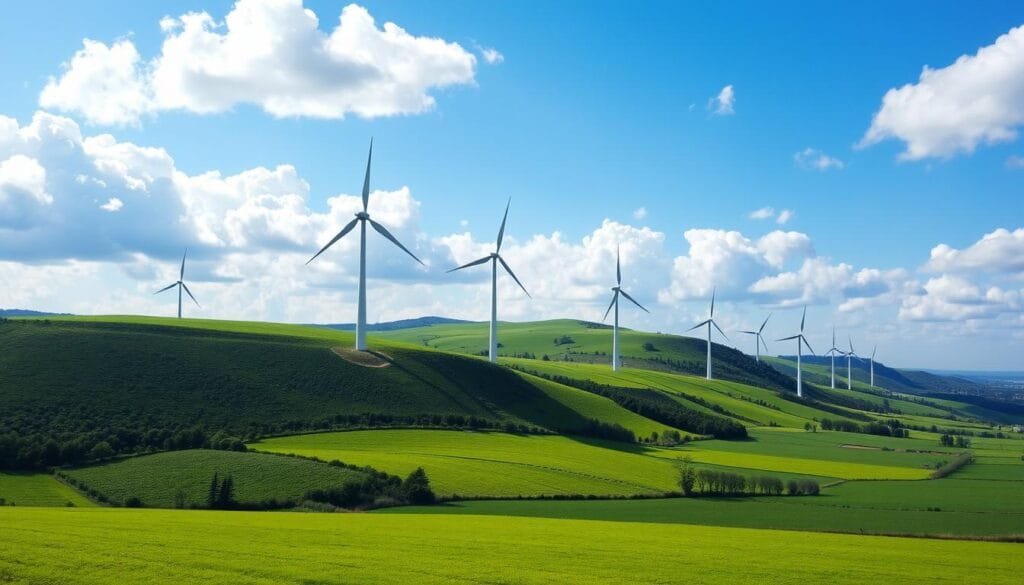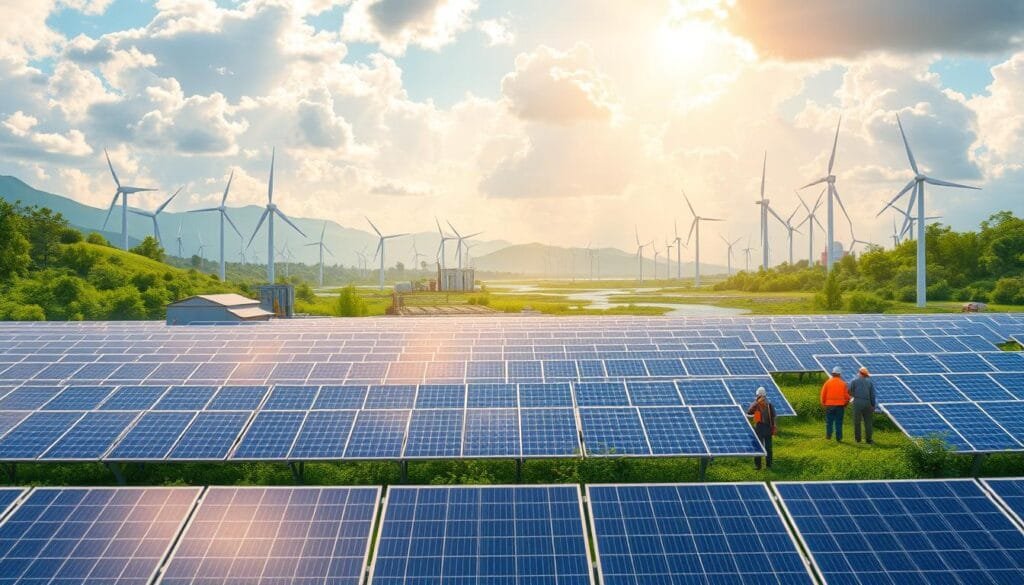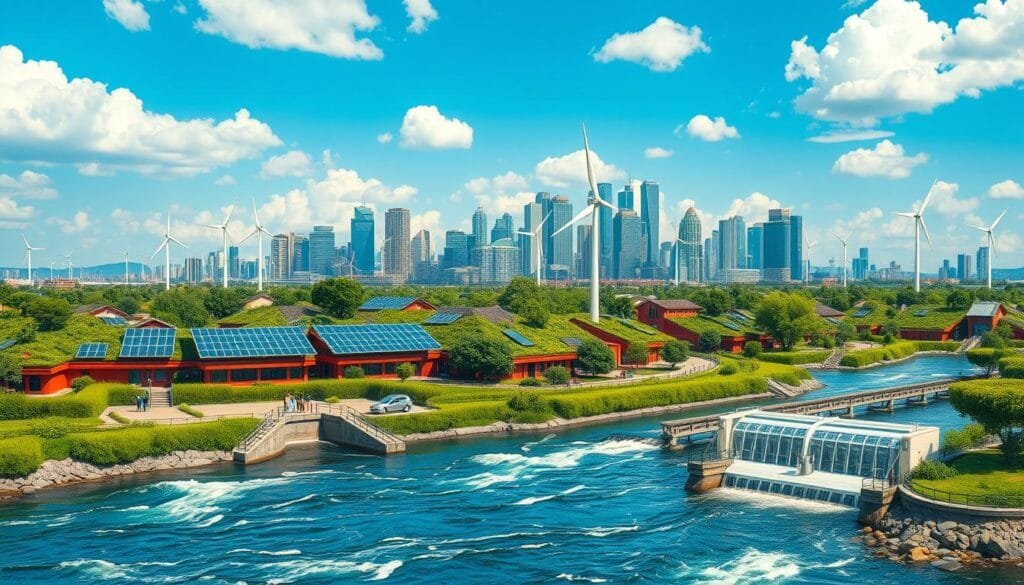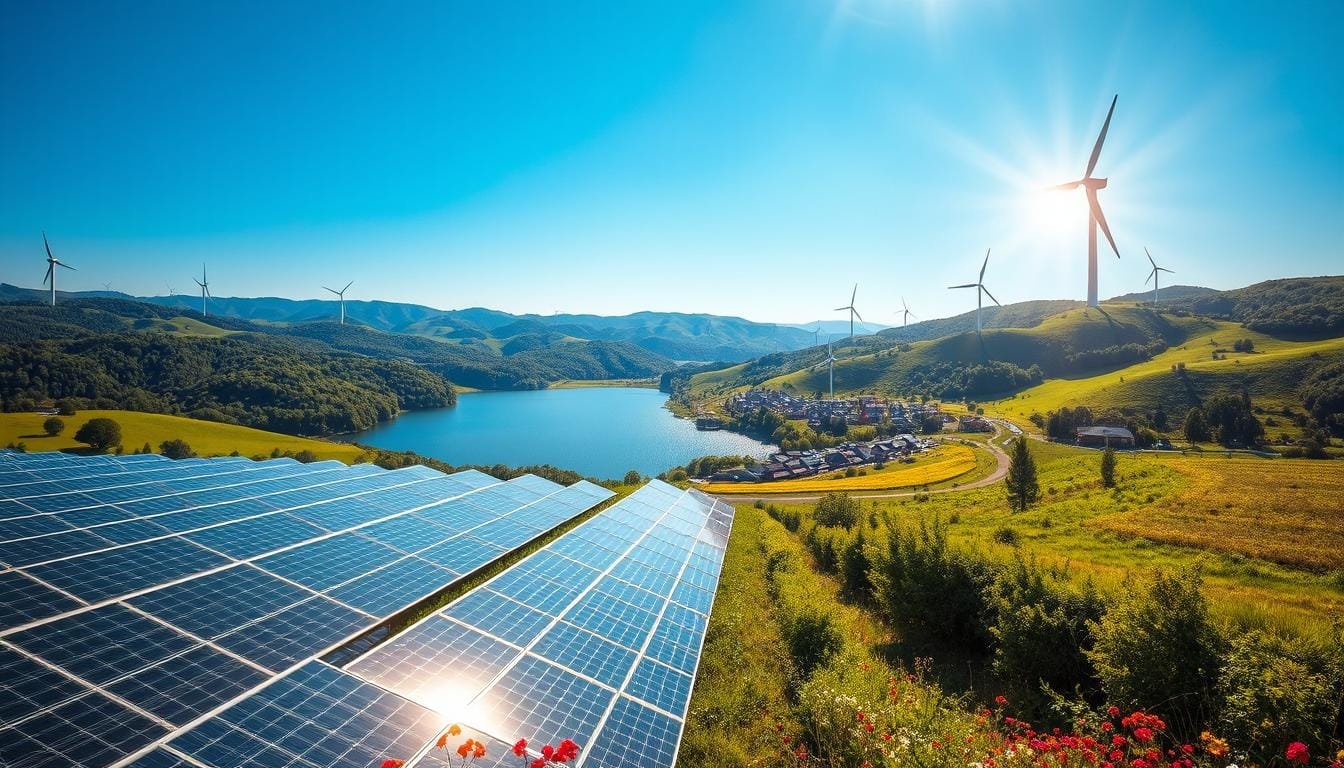About 29 percent of global electricity now comes from renewable sources. This marks a big change in the renewable energy world. As we face big climate challenges, clean energy is becoming key to solving our energy problems.
The way we get energy is changing fast. Old energy sources like fossil fuels are facing new competition from clean energy. Even though over 80 percent of energy is from old sources, we need to switch to clean energy fast.
Renewable energy is more than just an alternative. It’s a way to tackle big environmental, economic, and social issues. With solar, wind, hydro, and geothermal, we can cut carbon emissions and make energy systems stronger.
Key Takeaways
- Renewable energy sources now generate 29% of global electricity
- Clean energy technologies are rapidly becoming more cost-effective
- Transitioning to renewable energy can significantly reduce carbon emissions
- Sustainable power sources create new economic opportunities
- Innovation is driving the renewable energy revolution
Understanding the Global Energy Crisis
The world is at a turning point in energy use. Our heavy use of fossil fuels is pushing the planet to the edge. Now, countries are racing to switch to green electricity and a clean energy future.
The energy crisis is caused by several big issues. These problems threaten our planet and our economy:
- Record-breaking fossil fuel prices due to world politics
- More people on Earth means more energy needed
- High levels of greenhouse gas emissions
Current Dependency on Fossil Fuels
Fossil fuels are the main source of energy worldwide. They cause over 75% of greenhouse gas emissions. This has big effects on our economy and the environment:
| Energy Source | Global Emissions Contribution | Economic Impact |
|---|---|---|
| Coal | 44% | High infrastructure costs |
| Oil | 34% | Volatile pricing |
| Natural Gas | 20% | Geopolitical dependencies |
Environmental Impact of Traditional Energy Sources
Traditional energy sources are harming our planet. Carbon dioxide emissions from fossil fuels are changing our climate. This could have serious effects on our ecosystems for a long time.
“We are the first generation to feel the effect of climate change and the last generation who can do something about it.” – Barack Obama
The Urgent Need for Change
To fight climate change, we need to cut global emissions by almost half by 2030. We must reach net-zero by 2050. Switching to renewable energy is our best chance for a sustainable future. We need quick and big actions from everyone.
The Fundamentals of Renewable Energy Systems
Renewable energy is a new way to make power that’s good for our planet. It uses natural resources to make electricity without harming our limited energy sources.
“The future of energy lies in understanding and implementing clean, renewable sources that work in harmony with our environment.” – Climate Research Institute
There are many ways to make renewable energy:
- Solar photovoltaic technologies
- Wind power generation
- Hydroelectric power systems
- Geothermal energy extraction
- Biomass conversion methods
The UN’s Sustainable Development Goals show how important these clean energy sources are. SDG7 aims to make sure everyone has access to affordable, clean energy.
| Renewable Energy Source | Primary Application | Environmental Impact |
|---|---|---|
| Solar Energy | Electricity Generation | Zero Direct Carbon Emissions |
| Wind Power | Grid Electricity | Minimal Ecological Disruption |
| Hydroelectric | Large-Scale Power Production | Renewable Water Resource Management |
Renewable energy systems are not just technological solutions but pathways to a sustainable global future. By investing in these clean energy options, we can cut down on carbon emissions and meet growing energy needs.
Solar Power: Harnessing the Sun’s Power
Solar energy is a key part of renewable energy innovations. It offers a green way to change the world’s energy systems. The tech has grown a lot, making solar power a strong choice against old energy sources.
The history of solar tech shows big steps forward. The first useful solar cell was made in 1954 by Bell Labs. It had 6% efficiency. Now, we have advanced photovoltaic systems that are much better.
Photovoltaic Technology Advancements
Today’s photovoltaic tech is breaking new ground. Scientists are working on new ways to turn sunlight into electricity:
- Hybrid PV solutions combining different materials
- Bifacial PV modules catching sunlight from both sides
- Thermophotovoltaics turning heat into electrical energy
Solar Thermal Applications
Solar thermal tech does more than just make electricity. New ideas like Penn State’s dual cooling and power strategy show the future of energy.
The combined benefit of electricity generation and cooling can surpass traditional solar cell electricity savings by up to 30%.
Large-Scale Solar Projects Worldwide
| Project Type | Key Benefits | Potential Impact |
|---|---|---|
| Residential Installations | Lower energy bills, higher home value | Less reliance on the grid |
| Commercial Solar | Cost savings, meets rules | Big cut in operational costs |
| Urban Infrastructure | Solar-powered sidewalks, roads | Helps in making cities green |
The solar energy world is always changing. It promises a cleaner, brighter future for energy worldwide.
Wind Energy: Capturing Nature’s Force

Wind energy is a key part of the global shift to cleaner energy. It’s one of the fastest-growing areas for investment in renewable energy. Wind power is becoming a major player in making electricity in a sustainable way.
Today’s wind turbines are incredible feats of engineering. A single commercial wind turbine can power about 1,000 homes each month. It makes around 843,000 kilowatt-hours of electricity. Most wind farms in the U.S. have 50 turbines, showing how big this sector can get.
“Wind energy is not just about generating electricity; it’s about reimagining our relationship with energy production.” – Clean Energy Expert
Wind Energy Landscape in the United States
- Employs over 125,000 people as of 2022
- Potential for 600,000 jobs by 2050
- More than 500 manufacturing facilities nationwide
- Contributes to energy security and grid diversification
| Wind Turbine Characteristics | Details |
|---|---|
| Average Height (2022) | 321 feet |
| Propeller Blade Diameter | 429 feet |
| Minimum Operational Wind Speed | 7-11 miles per hour |
| Maximum Safe Wind Speed | 55 miles per hour |
New technologies are pushing wind energy forward. Longer blades, taller towers, and floating platforms are opening up new areas for wind farms. The cost of wind energy has dropped by 74% from 2008, making it a strong competitor to traditional energy.
Wind power is a big part of the move to cleaner energy. It can make electricity without any greenhouse gas emissions. This makes wind energy a key player in the shift to sustainable power.
Hydroelectric Power: Water’s Sustainable Force
In the world of renewable energy, hydroelectric power is a key player. It uses water’s power to create clean energy. This method turns water’s movement into electricity, making it a reliable and efficient way to generate power.
Hydropower is a vital part of renewable energy plans around the world. Its importance is shown in impressive statistics. It has become a key source of electricity globally.
Dam Systems and Power Generation
Hydroelectric power works through complex dam systems. These systems turn water’s energy into electricity. The main steps are:
- Water stored in reservoirs behind dams
- Controlled water release through turbines
- Spinning generators to produce electricity
Environmental Considerations
The impact of hydropower on the environment is complex. It offers benefits and challenges for sustainable growth.
| Positive Impacts | Potential Drawbacks |
|---|---|
| Zero carbon emissions | Ecosystem disruption |
| Renewable energy generation | Potential habitat alteration |
| Flexible electricity supply | Fish migration barriers |
Global Hydropower Projects
Hydropower’s importance worldwide is huge. It makes up more than 50% of renewable electricity. It’s essential for meeting global energy needs.
“Hydropower is not just an energy source; it’s a pathway to a sustainable future.” – Energy Research Institute
By 2023, hydropower’s installed capacity hit 1,416 GW. Conventional hydropower grew by 7.2 GW. Places like Washington show its power, getting 60% of their electricity from it.
Renewable Energy World: Current Status and Future Projections
The world is changing fast in the field of green electricity. Experts say we’re heading towards a bright future with clean energy. Renewable technologies are set to change how we power our homes and businesses.
- Renewables expected to contribute 80% of new power generation capacity by 2030
- Solar projected to account for over half of new renewable power capacity
- Global electricity from renewable sources approaching 50% by 2030
“The future of energy is renewable, and that future is happening now.” – International Energy Agency
New tech is making a big difference in green energy. Solar panel production is set to grow a lot. By the end of the decade, we’ll see a huge increase in clean energy systems.
| Renewable Energy Projection | 2030 Target |
|---|---|
| Renewable Power Capacity | 80% of new capacity |
| Solar PV Deployment | 500-800 GW |
| Global Electricity Mix | Approaching 50% |
The shift to clean energy is real and happening fast. Thanks to more investments and new tech, we’re seeing a big jump in renewable energy use.
Geothermal Energy: Earth’s Internal Heat
Geothermal energy is a strong eco-friendly option that uses the Earth’s heat. It taps into the Earth’s thermal resources, making it a sustainable and reliable power source.
The power of geothermal energy is amazing. The 2019 GeoVision analysis says the U.S. could make up to 60 gigawatts of electricity by 2050. This renewable energy source gives us power all day, every day.
Direct Use Applications
Geothermal energy has many uses beyond making electricity:
- Space heating for homes and businesses
- Industrial process heating
- Agricultural greenhouse warming
- District heating systems
Power Plant Technologies
Geothermal power plants use new tech to turn underground heat into electricity. The Enhanced Geothermal Shot™ analysis says we could reach 90 gigawatts by 2050.
| Geothermal Energy Characteristics | Key Statistics |
|---|---|
| Global Energy Mix Contribution | Less than 1% |
| Potential Global Energy Coverage | 31.5 billion years |
| Average Land Usage | 404 m² per gigawatt-hour |
| Emissions Comparison | 4-20 times lower than fossil fuels |
“Geothermal energy represents the frontier of sustainable power generation, giving us a clean and constant alternative to traditional energy.” – Renewable Energy Expert
As we look for new energy solutions, geothermal power is a key player. It helps meet our energy needs while being kind to the environment.
Economic Benefits of Renewable Energy

The shift to sustainable energy is changing the world’s economy. It’s creating new chances for growth and jobs. Renewable energy is leading a new economic model that benefits communities and countries.
The economic benefits of renewable energy are huge. The International Renewable Energy Agency (IRENA) says doubling renewable energy could boost global GDP by up to 1.1%. This could add about $1.3 trillion to the world’s economy by 2030.
“Renewable energy is not just an environmental solution, but an economic opportunity of unprecedented scale.” – Clean Energy Expert
Renewable energy is creating a lot of jobs:
- Over 10 million people work in renewable energy worldwide.
- Solar photovoltaic installer jobs are expected to grow 105% from 2016 to 2026.
- Wind turbine service technician roles are projected to increase by 96%.
- Wind farms make about $222 million a year for rural landowners.
Renewable energy does more than just create jobs. It boosts local economies, lowers energy costs over time, and fosters new tech.
Solar panels can also increase property values. Studies show homes gain about $20 in value for every dollar saved on energy bills. This makes renewable energy a wise financial choice.
The renewable energy sector is not just an alternative—it’s becoming the primary driver of economic innovation and sustainability.
Environmental Impact and Sustainability
The world is moving towards renewable energy to tackle big environmental issues. This shift is key for sustainable growth. It helps fight climate change and keeps our ecosystems healthy.
Investing in renewable energy brings big wins for the planet. Studies show how clean energy is changing our world:
- 35% of greenhouse gases come from old power plants
- Energy needs will grow by 56% by 2040
- The International Renewable Energy Agency says 90% of energy can be from renewables by 2050
Carbon Emission Reduction
Switching to renewable energy cuts down carbon emissions a lot. Clean energy technologies offer a green choice over fossil fuels. They help lessen the effects of climate change.
“Sustainable energy is not just an environmental imperative, but a pathway to global economic transformation.” – United Nations Sustainable Development Report
Ecosystem Preservation
Renewable energy is vital for keeping our ecosystems safe. It reduces harm to nature, helping animals and plants thrive. The move to sustainable energy shows we care about our planet and its needs.
Renewable energy also brings many jobs and sparks new ideas in the low-carbon field.
Technology Innovations in Clean Energy

The world of renewable energy is seeing a big change with new tech. In 2023, solar power led the way, making up most of the new energy sources.
New tech is changing the face of clean energy:
- Solar 3.0 technology uses 10 to 1000 times less material than traditional solar cells
- Innovative lithium-glass batteries offer double the energy density of conventional batteries
- Bladeless wind turbines from Vortex Bladeless generate energy without traditional rotating blades
“Innovation is the key to unlocking the full potential of renewable energy systems.”
New tech is opening up new possibilities in clean energy. Floating solar farms are now making more energy. Airborne wind energy systems are exploring new ways to collect wind power.
Artificial intelligence and machine learning are helping make renewable energy better. They’re improving how we manage energy grids.
Hydrogen is also getting a lot of attention as a clean energy source. It could meet 20% to 30% of transport energy needs and 5% to 20% of industrial energy by 2050.
Materials science is making renewable energy cheaper and more accessible. Solar panels made from food waste and sustainable tires are just a few examples. These innovations are changing the renewable energy world.
Global Investment and Policy Frameworks
The world is moving towards green electricity, needing huge money and smart policies. Governments and companies are seeing the importance of investing in clean energy to fight climate change.
Renewable energy is getting a big boost in investment. In 2023, over $1.77 trillion was spent on renewable energy, up 17% from the year before.
Government Initiatives Driving Change
Governments are making big moves to push for clean energy:
- The United States’ Inflation Reduction Act gives $369 billion for clean energy projects
- European Union’s “Fit for 55” package aims for 55% less emissions by 2030
- India wants to hit 500 GW of renewable energy by 2030
Private Sector Participation
Private money is key to making green electricity a reality:
| Investment Metric | Percentage |
|---|---|
| Total Global Renewable Energy Investments (Private) | 75% (2013-2020) |
| Solar PV Technology Private Finance | 83% in 2020 |
| Institutional Investors with Renewable Investments | Less than 20% |
“The future of energy is not just about generation, but strategic investment in sustainable technologies.” – Clean Energy Research Institute
BloombergNEF says we need $4.5 trillion a year in clean energy investment to reach Net Zero by 2050. This big goal needs teamwork from governments, investors, and global groups.
Challenges and Solutions in Renewable Implementation
The journey to make eco-friendly energy solutions common faces many hurdles. These include both technical and social obstacles. To overcome these, we need new ideas and careful planning.
Some major challenges are:
- Intermittency of renewable energy sources
- Grid integration complexities
- Energy storage limitations
- High initial investment costs
- Regulatory inconsistencies
New technologies are helping to solve these problems. For example, smart grids make energy distribution better. Also, new battery technologies are improving how we store energy.
“The future of renewable energy depends on our ability to overcome current technological limitations”
| Challenge | Potential Solution |
|---|---|
| Energy Storage | Advanced lithium-ion battery technologies |
| Grid Resilience | Smart grid optimization systems |
| Public Acceptance | Community engagement and education programs |
To move forward, we need to focus on sustainable development and smart investments. Continued research and working together are key. They will help us get past the current hurdles and move towards cleaner energy faster.
Conclusion
The world is at a turning point when it comes to energy. Right now, only 11.4% of our energy comes from renewable sources. This shows how badly we need to switch to sustainable energy.
Fossil fuels are the main source of energy, making up 84.3% of what we use. But, things are starting to change.
New ways of making energy are changing how we power our lives. The amount of renewable energy has grown a lot, reaching 510 gigawatts in 2023. This is a 50% jump from the year before.
Solar energy is leading the way, making up about 75% of new renewable energy. The cost of solar panels has also dropped by nearly half in just one year.
We need to take big steps forward. Experts say we could see 7,300 GW of renewable energy by 2028. Solar and wind will be the main drivers of this growth.
Already, 16.2 million jobs in 2023 show the economic benefits of clean energy. As more countries focus on clean energy, we’re on the edge of a big change in how we power our world.
We need a complete plan to move forward. By supporting new energy technologies and good policies, we can make our energy system better. This will make our world more sustainable and strong.
The road ahead is tough, but the benefits are huge. We can make a big difference for the better.

